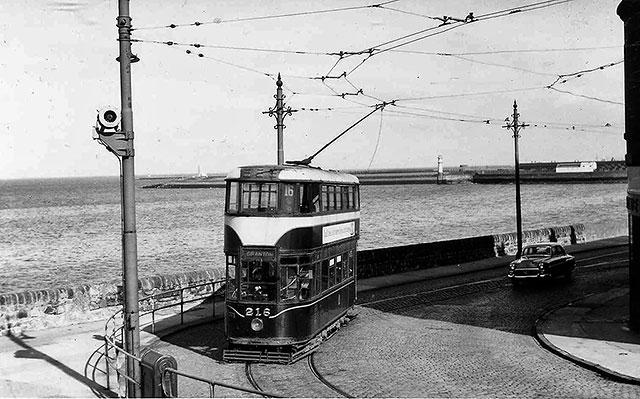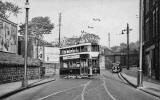|
Trinity Crescent |
1.
Looking to the east along Trinity Crescent
towards Old Chain Pier and Newhaven
© JL Stevenson Collection . Reproduced with acknowledgement to Kenneth Williamson, Silverknowes, Edinburgh. Photo taken 1962
2.
Looking to the east along Trinity Crescent
as tram 216 travels towards the camera as it approaches
Trinity Bridge on its way to the Granton terminus.
The lighthouse at the entrance to Newhaven Harbour can be seen in the
background.
© JL Stevenson Collection . Reproduced with acknowledgement to Kenneth Williamson, Silverknowes, Edinburgh.
3.
Looking to the east along Lower Granton Road
as tram 222 travels away from the
camera as it approaches Trinity Bridge on its way to the Churchhill
terminus.
Trinity Bridge is behind the lamp post o n the left. Don't some of the old
cars look small!
© JL Stevenson Collection . Reproduced with acknowledgement to Kenneth Williamson, Silverknowes, Edinburgh.
|
Recollections 1. Kenneth Williamson Silverknowes, Edinburgh |
|
Thank you to Kenneth Williamson for sending me Photo 1 above. Kenneth wrote: |
|
The Old Chain Pier "I was reading about the Old Chain Pier. I remember it in Betty Moss' time. Here is a picture, courtesy of Hamish Stevenson showing the pub. Although the picture was taken in 1962, well after the trams stopped running, the tracks are still there." Kenneth Williamson, Silverknowes, Edinburgh: April 24, 2014 |
|
Reply The Old Chain Pier The Old Chain Pier is the small building on the left-hand side of the road, beside the Firth of Forth, in this photo, with the two boys approaching it along the pavement. The Church The church in the mist, in the distance, is close to Newhaven Harbour. It has now been converted to become 'Alien Rock' , a hollow shell of a building with its inner walls converted to become an indoor climbing centre. Edinburgh Trams Edinburgh's trams stopped running in 1956, about 6 years before this photo was taken, but as Kenneth says, the tram lines were still in place when this photo was taken. The road sign, the back of which can be seen on the right-hand side of this photo is presumably a 'Tram Pinch' sign, warning the traffic that trams were about to share a single trace with oncoming trams for the next section of road (close to where the photo was taken from) as it passed under around a double bend and under a rail bridge at the foot of Trinity Road. The railway bridge has since been removed, and the double bend is now in the process of being removed from this section of road. Peter Stubbs, Edinburgh: May 3, 2014 |
|
Recollections 2. Kenneth Williamson Silverknowes, Edinburgh |
|
Two More Photos Thank you to Kenneth Williamson for writing again, this time sending two more photos from Hamish Stevenson's collection taken nearby. They are: - Photo 2: Tram 216 at the tram pinch in Trinity Crescent, approaching Trinity Bridge from the east on its way to Granton terminus. - Photo 3: Tram 222 at the tram pinch in Lower Granton Road, approaching Trinity Bridge from the west on its way to Churchhill terminus. Acknowledgement: Kenneth Williamson, Silverknowes, Edinburgh: May 5, 2014 |
|
Questions Q.1 What is that mounted high on the lamp post in Photo 2? I remember there being a foghorn or siren of some sort near this corner in the 1970s. Q.2. What is that mounted high on the lamp post in Photo 3? Is it a camera? Does it have any connection with the tram pinch on this section of road? Peter Stubbs, Edinburgh: May 6, 2014 |
|
Recollections 3. David Bain Rotherham, South Yorkshire, England |
|
Thank you to David Bain who replied: |
|
Photo 3 Old Cars and Trams "Your caption: "Don't some of the old cars look small!" made me do some lateral thinking. ie Don't the trams look small! Most of us oldies would be kids in the days of the old trams and remember them as being big because we were small! It would be interesting to see an old tram and a new tram side by side to prove just how small the old trams were and just how big the new ones are." David Bain, Rotherham, South Yorkshire, England |
|
Recollections 4. Brian Alexander Prestonfield, Edinburgh |
|
Thank you to Brian Alexander who replied: |
|
Photo 2 Air Raid Siren "I loved the photos of the trams (216 & 222) at Trinity Bridge The large round object situated on the lamp post in Photo 2 is an Air Raid Siren. They were more usually situated on the roof of the police boxes round the town. Some survived into the 1970s, I believe. I think they were tested every year up to the early-1960s to ensure they still worked (perhaps in case they were needed to give the 'Four Minute Warning' of a nuclear attack. I have a vague recollection of hearing them being tested in the late-1950s." Car "The car behind tram 216 in the second photo is a Vauxhall Velox made between 1948 & 1965." Photo 3 Box on the Pole "I have no idea what the box with the two round objects in Photo 3 is. I don't recollect ever noticing this one at Trinity Bridge, or in any other location." Car "The car parked with its wheels on the pavement in Photo 3 is, I think, an Austin but I'm not sure which model." Brian Alexander Prestonfield, Edinburgh: May 7, 2014 |
|
Recollections 5. David King Trinity, Edinburgh |
|
Thank you to David King who replied: |
|
Photo 2 Air Raid Siren "The object in this photo is, indeed, a siren. It was moved to its own pole near the top of the steps to the beach and survived until a few years ago. The pole (with nothing on top of it) was uprooted and removed within the last two weeks Photo 3 Box on the Pole "The box on this pole is a light signal for trams only. There was another one on Trinity Crescent, outside No 10 approximately. The purpose was to avoid head-on collisions on the single line stretch of track under the bridge, which was ‘blind’ from both directions. I don’t know exactly how it operated, but I understand that the conductor pulled a handle of some kind when the tramcar was about to enter the single line, and the driver got a light indicating clear if the gear had not been operated at the other end within some short time before. It’s not quite about the tram pinch – i.e. the rails coming close to the kerb, a hazard to other road traffic - it was just for the trams. I can’t immediately find the reference but am fairly sure that in one of the books on the subject it was stated that the equipment was purpose designed, possibly by David L Hunter who was employed by the Tramways Department at the time, and incorporated electrical relays as well as the lights." David King, Trinity, Edinburgh: May 7, 2014 |
|
Recollections 6. Frank Wilson Wester Hailes, Edinburgh |
|
Thank you to Frank Wilson who replied: |
|
Photo 3 Box on the Pole "The box on this post has the warning lights for the trams. There was another box on the Chain Pier side of Trinity Bridge. The round discs on this box are the green and red lenses. They were operated mechanically, using a long steel rod from the bottom of the box, by the conductor. I'm not sure, but I think the conductor also changed the points. When buses were introduced they also used these boxes till traffic lights were installed."
Frank (Frances) Wilson, Wester Hailes, |
|
Recollections 7. David King Trinity, Edinburgh |
|
Thank you to David King for writing again. David wrote: |
|
Photo 3 The Points "It was good to see Frank Wilson's comments above - but I don’t think anybody had to change the points. Like most tramway points, they had only one moveable blade which was sprung so that it sat in the correct position for a ‘facing movement’, i.e. taking the left hand track when approaching from the single line end, but moved across when approached from the ‘trailing’ end, being forced over by the flange of the wheels. This of course caused a problem if a tramcar had to pass through it in the opposite direction but all being well that shouldn’t have happened. When it did, I suspect the blade was wedged in position temporarily with some suitable object being jammed into the gap between the blade and the rail." David King, Trinity, Edinburgh: May 8, 2014 |
|
More photos: Old Chain Pier Trinity Crescent |





